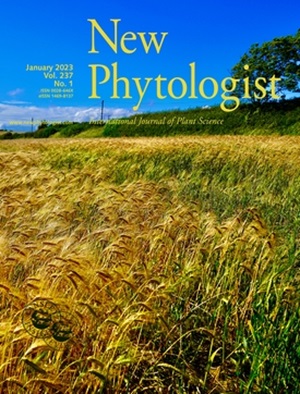植物有机氮营养:成本、效益和碳利用效率
IF 8.3
1区 生物学
Q1 PLANT SCIENCES
引用次数: 0
摘要
摘要 有机氮(N)化合物和无机氮(N)化合物在土壤流动性和同化成本方面的差异,可能会诱发植物表型的可塑性,从而优化对不同氮形式的获取和利用。在此,我们对这一假设进行了实验和理论评估。我们在分根设置中种植拟南芥,并结合稳定同位素标记来研究从l-谷氨酰胺(l-gln)和NO3-中摄取碳(C)和氮(N)的情况和分布,并评估氮源对生物量分配和碳利用效率(CUE)的影响。稳定同位素分析表明,从l-谷氨酰胺中获得的碳有40-48%残留在植物体内,占芽和根总碳量的7-8%。生长在l-gln上的植物表现出根的质量分数和根毛长度增加,单位根生物量的氮吸收率显著降低,但CUE却显著提高。我们的数据表明,有机氮营养与根和根毛广泛生长的特定表型有关,这种表型有利于吸收流动性较差的氮。增加的 CUE 和单位根生长量较低的氮吸收量可能是与有机氮表型相关的关键因素。本文章由计算机程序翻译,如有差异,请以英文原文为准。
Plant organic nitrogen nutrition: costs, benefits, and carbon use efficiency
Summary Differences in soil mobility and assimilation costs between organic and inorganic nitrogen (N) compounds would hypothetically induce plant phenotypic plasticity to optimize acquisition of, and performance on, the different N forms. Here we evaluated this hypothesis experimentally and theoretically. We grew Arabidopsis in split‐root setups combined with stable isotope labelling to study uptake and distribution of carbon (C) and N from l ‐glutamine (l ‐gln) and NO3 − and assessed the effect of the N source on biomass partitioning and carbon use efficiency (CUE). Analyses of stable isotopes showed that 40–48% of C acquired from l ‐gln resided in plants, contributing 7–8% to total C of both shoots and roots. Plants grown on l ‐gln exhibited increased root mass fraction and root hair length and a significantly lower N uptake rate per unit root biomass but displayed significantly enhanced CUE. Our data suggests that organic N nutrition is linked to a particular phenotype with extensive growth of roots and root hairs that optimizes for uptake of less mobile N forms. Increased CUE and lower N uptake per unit root growth may be key facets linked to the organic N phenotype.
求助全文
通过发布文献求助,成功后即可免费获取论文全文。
去求助
来源期刊

New Phytologist
生物-植物科学
自引率
5.30%
发文量
728
期刊介绍:
New Phytologist is an international electronic journal published 24 times a year. It is owned by the New Phytologist Foundation, a non-profit-making charitable organization dedicated to promoting plant science. The journal publishes excellent, novel, rigorous, and timely research and scholarship in plant science and its applications. The articles cover topics in five sections: Physiology & Development, Environment, Interaction, Evolution, and Transformative Plant Biotechnology. These sections encompass intracellular processes, global environmental change, and encourage cross-disciplinary approaches. The journal recognizes the use of techniques from molecular and cell biology, functional genomics, modeling, and system-based approaches in plant science. Abstracting and Indexing Information for New Phytologist includes Academic Search, AgBiotech News & Information, Agroforestry Abstracts, Biochemistry & Biophysics Citation Index, Botanical Pesticides, CAB Abstracts®, Environment Index, Global Health, and Plant Breeding Abstracts, and others.
 求助内容:
求助内容: 应助结果提醒方式:
应助结果提醒方式:


